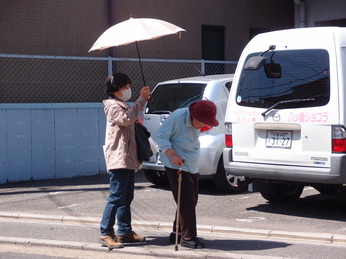Dangerous Compassion
December 17, 2015 • By Jason Danely
“Sure, caring is exhausting!” Hamada-san told me as she brought another cup of tea to the table. “But there is nothing in life that you learn more from than caring.” Hamada-san, a Japanese woman living in the Kansal region who cared for her mother for ten years , explained to me how she learned to attend to and respond to her mother’s needs, even when her dementia had progressed to the point where she could no longer speak. Other family carers I spent time with had the same patient and attentive ease Hamada-san described, whether they were helping a parent use the toilet or feeding small spoonfuls of mashed food to an ailing spouse. Some compared these everyday tasks to a kind of Buddhist “spiritual training,” reminding me of what Harvard anthropologist Arthur Kleinman wrote about the necessity of “endurance” for finding within ourselves the love, strength, and compassion to care for others.
With the oldest and longest-living population in the world—where the majority of older people with care needs are supported by one or more family members—Japan is a laboratory of compassion, one that may come to resemble our global future as the world’s population ages. Becoming more compassionate enhances the lives of carers and the cared-for in Japan, but to what degree is this a product of particular cultural narratives rather than a universal fact?
Science helps us out here. Biological anthropologists have found that socio-moral emotions like compassion were critical to human cognitive evolution, to the degree that it is literally part of our neurochemistry to be compassionate. Archaeologists have found evidence of widespread long-term care for injured persons as far back as the Upper Paleolithic period, beginning about 40,000 years ago. By the Neolithic period, there is evidence that some individuals with severe disability, even lower body paralysis, were able to survive for years through the care of others. These findings, which depart significantly from the care found in non-human primate societies, show that compassion isn’t just a moral guide. It’s a vital part of our survival as a species.
As biomedical care has become more accessible and widespread over the past century, many of us have grown comfortable outsourcing care to professionals. Health care and social care have become synonymous with bureaucratic systems, not with family and community. While care labor still demands compassionate responses on the part of nurses, physicians, and other care workers, the system as a whole—with its efficient (brief) contact time with patients, the standardization of care, and the ever-present “bottom line” of profit—often produces less-than-compassionate results for patients and families.
That said, one area where compassion is still overwhelmingly practiced by ordinary families is elder care. In Oxfordshire, where I live, it is estimated that women born in the 1990s will spend an average of nine years of their life caring for a disabled, ill, or older person. In Japan, this is the case for the current generation. As carers told me their stories, their mistakes and regrets, as well their moments of quiet joy, they often came back to the theme of compassion.
Compassion is not without risk. In fact, compassion can be dangerous. Rev. Dr. Martin Luther King Jr. said as much in his last speech before he was assassinated, when he called on us to "develop a kind of dangerous unselfishness." Compassion is unselfish because it reaches out to place a hand on the one that suffers, only to realize that the suffering is one's own. The mutual vulnerability of compassion is dangerous; it demands a courage and acceptance of the human condition that does not come easily to the average person outside a narrow circle of friends and family, let alone to our social institutions. No wonder compassion is something that figures strongly in religion. But must one be something close to the Dalai Lama to truly practice compassion?
Thankfully, no. I don’t think we are so different from our Stone Age ancestors. Hamada-san would likely recognize the ways they cared for their infirm and praise their endurance. Compassion is part of our past and our present—but how might a new regard for compassion, in all its varied cultural forms, take us into the future? Looking closely at the lived experiences of family carers across different cultures helps us realize that enhancing life in an aging world will mean reflecting on fundamental ways of being in the world with each other. Such reflections, grounded in narratives of exhausted bodies and enduring spirits, are not always easy, but it may be the case that reshaping the values of individuals, governments, and international movements takes precisely this kind of dangerous compassion.
Read a Q&A with Jason Danely about his research here.
Photo courtesy of Jason Danely